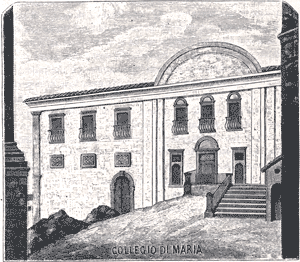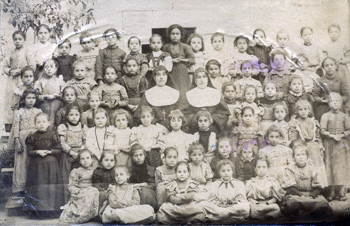The Maria College  To the left of the Chiesa del Rosario (Rosary Church), in an alley nearly hidden (via Giovanni Piccino), you find the entry of the Maria College (a building complex that extends itself as a rectangle until the Vincenzo Scafiti street). To the left of the Chiesa del Rosario (Rosary Church), in an alley nearly hidden (via Giovanni Piccino), you find the entry of the Maria College (a building complex that extends itself as a rectangle until the Vincenzo Scafiti street).
It was built, on design by the arch. D. Basilio Gullo, for initiative of "donna" Maria Scafiti and her three clergymen brothers, Vincenzo, Mariano and Raffaele and the head priest Vincenzo Uccellatore. On May 19 1780, the king Ferdinand gave Maria Scafiti the faculty to found in Bronte a College of Maria for the education and instruction of poor and orphan girls. The Maria’s colleges were instituted to help the weaker and needier society, with rules approved by the Pope, where was given free to young girls, poor and orphan or "figlie della ruota" (daughters of the “wheel”), shelter, maintenance and education religious and literary, “looking for them, if necessary, even in the streets”. Several of these were founded in Sicily and kept by generous benefactors in many communities (the first one was instituted in Palermo in 1731). Two years earlier (1778), with thee opening of the Capizzi College, founded by Ignazio Capizzi, the problem of formation and scholastic instruction for the young men had been resolved. But the girls of Bronte were excluded. It was unthinkable at the time that some of them could frequent the school rooms of the Capizzi College. To help complete the work, another benefactor, the generous priest, Giovanni Piccino , intervened in 1794.
«By act of last will of April 15, 1794», he left his entire income «in many marriage legacies of 5 ounces each to be conferred ("given by lot") to poor and needy women» and the other half «as a dowry for a College of Mary to be founded in Bronte, and for which construction had begun». But even with this generous legacy of Giovanni Piccino it was not possible to immediately complete the works and open the schools to the young women of Bronte.  The work continued slowly also because the College had to sustain long disputes with some heirs of the generous benefactors and with the Duchy which claimed credits for unpaid censuses. In the meantime, the first floor was built (the date 1818 is carved into the pediment of the entrance portal) but it was not yet possible to open the Institute. The work continued slowly also because the College had to sustain long disputes with some heirs of the generous benefactors and with the Duchy which claimed credits for unpaid censuses. In the meantime, the first floor was built (the date 1818 is carved into the pediment of the entrance portal) but it was not yet possible to open the Institute.
The opening of the College of Mary wanted by Maria Scafiti was slow to get going and then, as Ignazio Capizzi had done for the young males, another priest, Pietro Graziano Calanna, returning to Bronte after forty years spent in Monreale, Rome and Naples, strong in the Roman experience for the benefit of the young, conceived and planned the female school education in Bronte giving life in 1823 to another institution, the "Royal Public Schools" intended for the young Bronte girls. In the meantime, the "Pia Opera Piccino" passed in the second half of the 19th century into the hands of the Congregation of Charity. Its premises (those facing Via Luigi Capuana) were also used as the Municipal Chancellery and during the tragic events of 1860 set on fire with the entire municipal archive. «This institution, - writes mons. Adolfo Longhitano - who for over a century had carried out a meritorious service as a substitute teacher in Sicily, entered into crisis after the unification of Italy, when the State decided to establish public schools in all the municipalities and began a vexatious policy towards the Colleges of Mary, considered a relic of the old regime, because they promoted a private and confessional school; wanting to affirm a model of public and secular school, he decided to suppress these institutions. In Bronte, the College of Mary, thanks to the decisive action of Bishop Giuseppe Benedetto Dusmet, managed to avoid suppression and start its own activity in 1881, when the original model had by then been surpassed and a new identity was being sought to adapt to the new laws of the State.
This new identity was given by the Daughters of Mary Help of Christians, called by Bishop Dusmet himself, as he reports in his report presented in Rome in 1881». Two years earlier, in 1879 - thanks to the interest of two priests, Giuseppe Di Bella , rector of the Real Collegio Capizzi, and Giuseppe Prestianni, then procurator of the church of the Rosary - the Daughters of Mary Help of Christians (female branch of the Salesian Society founded a few years earlier, in 1872, by St. John Bosco) were called to run the College, dedicated to the education and instruction of young people.
On the evening of October 15, 1880, welcomed with great enthusiasm by the population of Bronte, six nuns left for Bronte from the distant Mother House in Nizza Monferrato.
We like to remember their names: the director Sister Felicia Mazzarello, the teachers Angiolina Buzzetti, Ice Bianchi, Carolina Sartore, Giacinta Marzone and the assistant Sister Battistina Camera. To the nuns - wrote the mayor of the time, cav. Gennaro Baratta to Duke Nelson (1881) was paid a salary «of L. 500 each for each year, in addition to travel and accommodation expenses» which had to be «complete with all furniture, linens and furnishings, bed, table and kitchen».
A few years later, thanks to the interest of Fr. Prestianni and the bishop, after almost a hundred years from its foundation, the Charitable Institution "Collegio di Maria" finally saw its statute approved (with a royal decree of 1 August 1885) and began its charitable work.  The Salesian Sisters (the one in Bronte was the first foundation of the 16 that opened on the Island up to 1908) have carried out their generous work up to the present day. The Salesian Sisters (the one in Bronte was the first foundation of the 16 that opened on the Island up to 1908) have carried out their generous work up to the present day.
The purpose for which the Collegio di Maria was born is now naturally outdated; but the vitality of the Institute and the tireless work of the Sisters of Don Bosco in the education and formation of the young women of Bronte have not ceased.
(nL, May 2006) In 1879 to conduct the college were called the Daughters of Maria Ausiliatrice (female branch of the Salesian company founded by S. Giovanni Bosco in 1872) and dedicated to the education and instruction of young girls.
The Salesian Sisters (the one of Bronte was the first foundation of the sixteen that opened in the island up to 1908) have been lavishing their generous work since then till today. The purpose for which it was born, Maria's College is today obviously outdated; but the tireless work of the nuns in the education and the formation of the young women of Bronte has never ceased. |